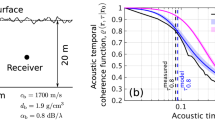Abstract
High-frequency broadband (200–300 kHz) acoustic scattering techniques have been used to observe the diffusive regime of double-diffusive convection in the laboratory. Pulse compression signal processing techniques allow (1) centimetre-scale interface thickness to be rapidly, remotely, and continuously measured, (2) the evolution, and ultimate merging, of multiple interfaces to be observed at high-resolution, and (3) convection cells within the surrounding mixed layers to be observed. The acoustically measured interface thickness, combined with knowledge of the slowly varying temperatures within the surrounding layers, in turn allows the direct estimation of double-diffusive heat and buoyancy fluxes. The acoustically derived interface thickness, interfacial fluxes and migration rates are shown to support established theory. Acoustic techniques complement traditional laboratory sampling methods and provide enhanced capabilities for observing the diffusive regime of double-diffusion in the ocean.






Similar content being viewed by others
References
Chu D, Stanton T (1998) Application of pulse compression techniques to broadband acoustic scattering by live individual zooplankton. J Acoust Soc Am 104:39–55
Deardorff JW (1970) Convective velocity and temperature scales for the unstable planetary boundary layer and for Rayleigh convection. J Atmos Sci 27:1211–1213
Efron B, Gong G (1983) A leisurely look at the bootstrap, the jacknife, and cross-validation. Am Stat 37:36–48
Fofofnoff N, RC Millard J (1983) Algorithms for computation of fundamental properties of seawater. Tech. rep., UNESCO, Paris
Huppert HE (1971) On the stability of a series of double-diffusive layers. Deep Sea Res 18:1005–1021
Kelley D (1987) Interface migration in thermohaline staircases. J Phys Oceanogr 17:1633–1639
Kelley D (1990) Fluxes through diffusive staircases, a new formulation. J Geophys Res 95:3365–3371
Kelley D, Fernando H, Gargett A, Tanny J, Ozsoy E (2003) The diffusive regime of double-diffusive convection. Prog Oceanogr 56:461–481
Lavery A, Ross T (2007) Acoustic scattering from double-diffusive microstructure. J Acoust Soc Am 122(3):1449–1462
Lavery AC, Schmitt RW, Stanton TK (2003) High-frequency acoustic scattering from turbulent oceanic microstructure: the importance of density fluctuations. J Acoust Soc Am 114:2685–2697
Linden PF, Shirtcliffe TGL (1978) The diffusive interface in double-diffusive convection. J Fluid Mech 87:417–432
McDougall TJ (1981) Double-diffusive convection with a nonlinear equation of state, Part II. Laboratory experiments and their interpretation. Prog Oceanogr 10:91–121
Muench RD, Fernando HJS, Stegen GR (1990) Temperature and salinity staircases in the Northwestern Weddell Sea. J Phys Oceanogr 20:295–306
Neal VT, Neshyba S, Denner W (1969) Thermal stratification in the Arctic Ocean. Science 166:373–374
Robertson R, Padman L, Levine MD (1995) Fine structure, microstructure, and vertical mixing processes int he upper ocean in the western Weddell Sea. J Geophys Res 100(C9):18517–18535
Ross T, Garrett C, Lueck R (2004) On the turbulent co-spectrum of two scalars and its effect on acoustic scattering from oceanic turbulence. J Fluid Mech 514:107–119
Schmitt RW, Millard RC, Toole JM, Wellwood WD (2005) A double-diffusive interface tank for dynamic-response studies. J Mar Res 63:263–289
Stanton TK, Chu D (2008) Calibration of broadband active acoustic systems using a single standard spherical target. J Acous Soc Am 124:128–136
Turner JS (1965) The coupled turbulent transports of salt and heat across a sharp density interface. Int J Heat Mass Transf 8:759–767
Turner JS (1973) Buoyancy effects in fluids. Cambridge University Press, Cambridge
Turner JS (1974) Double-diffusive phenomena. Annu Rev Fluid Mech 6:37–55
Worster MG (2004) Time-dependent fluxes across double-diffusive interfaces. J Fluid Mech 505:287–307
Acknowledgments
We thank Ray Schmitt for the use of his tank, Dan Kelley for useful comments on the manuscript, and the Doherty Foundation for funding Tetjana’s postdoctoral scholarship at WHOI. Funding for this project was provided by the Ocean Acoustics program at the Office of Naval Research, and by the WHOI Cecil and Ida Greene Technology Award.
Author information
Authors and Affiliations
Corresponding author
Rights and permissions
About this article
Cite this article
Ross, T., Lavery, A. Laboratory observations of double-diffusive convection using high-frequency broadband acoustics. Exp Fluids 46, 355–364 (2009). https://doi.org/10.1007/s00348-008-0570-9
Received:
Revised:
Accepted:
Published:
Issue Date:
DOI: https://doi.org/10.1007/s00348-008-0570-9




